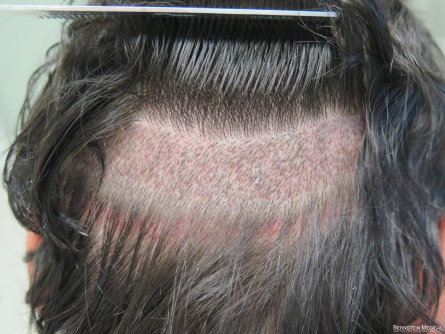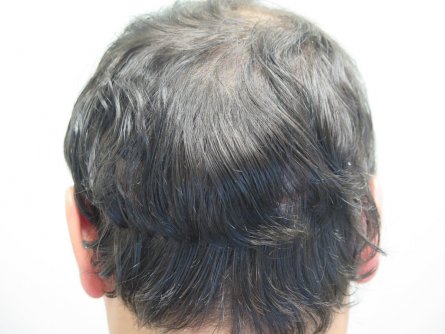Robert M. Bernstein, MD
Restoration Robotics White Paper. May 2015.
Introduction
The physician-assisted ARTAS® Robotic System facilitates hair restoration surgery through minimally invasive follicular unit harvesting. High resolution digital imaging and precision robotics identify and select the optimal follicular units for harvesting in order to improve the outcome in patients undergoing follicular unit extraction (FUE) procedures. Its advantage over other traditional techniques can be attributed to precise graft harvesting, minimal post-op discomfort, and no linear donor scar. The ARTAS robotic system delivers speed, accuracy, and reproducibility to the FUE procedure. It changes the experience for patients undergoing surgical hair restoration by eliminating the drawbacks associated with older, more invasive methods such as strip harvesting.
A limitation of FUE procedures is the short-term cosmetic problem of clipping the entire donor area in the back and sides of the scalp. The long-hair robotic technique avoids this problem by harvesting through a broad band of clipped hair that is covered with longer hair combed down over the harvested area. This technique enables the physician to harvest relatively large amounts of donor hair without shaving the patient’s entire scalp.
Case Study
This patient is a Norwood Class 5 with a donor density of 70 FU/cm2. He had two prior hair transplant procedures using a total of 3,224 follicular unit grafts which were harvested via a donor strip (FUT-strip). Because the procedure resulted in a widened donor scar, the patient chose to have a third hair transplant procedure using robotic FUE (R-FUE). The patient’s main concern was that his widened donor scar would be detectable after the procedure.
For the procedure, the patient grew his hair a bit longer than he usually wears it. At the time of the procedure, we lifted up a section of his hair and shaved a band of hair to 1mm (using Peanut clippers) to serve as the donor site. A 19-gauge system was used for harvesting through one horizontal row of overlapping grids. Site spacing was set at 1.7mm and a total of 1,086 grafts were harvested. To help to camouflage three hundred grafts were placed into his linear donor scar and the remaining 786 grafts were place in the front and top of his scalp.
After the procedure, the patient combed his hair down to camouflage the area until his shaved hair grew back. Routine post-op care was advised, including cleaning the donor and recipient areas with GraftCyte shampoo and applying bacitracin ointment to the donor area.
Photos courtesy of Bernstein Medical – Center for Hair Restoration
Discussion
A concern of many patients who are considering an FUE procedure is the short-term cosmetic problem of an exposed donor area. For the first 10 days after an FUE procedure, the donor wounds are healing and the area is generally erythematous and slightly crusted. This presents an obvious cosmetic problem for a working or otherwise socially active person. At 10 days post-op the harvested sites are healed to a degree that the wounds are barely detectable; however, the short hair growing back in the donor area can still be a tell-tale sign that a procedure had been performed.
A long-hair robotic FUE procedure avoids detectability during the 10 day post-op period when the donor area is still healing. It also eliminates the need to modify ones hair style during the time needed for the clipped back and sides to grow in.
Long-hair robotic FUE procedures are generally performed through one, long band or through two separate parallel bands above and below a linear donor scar. Corners are generally rounded and edges feathered to blend in with the surrounding hair. Multiple thin, well demarcated strips should be avoided so that there is no striped or geometric pattern visible if the patient desires to wear his hair very short.
In our experience, the number of grafts that can be harvested using this technique ranges from 1,200 to 1,600 grafts in a single session when one long, thin band is used. This band is created by the placement of a single horizontal row of overlapping tensioner grids that runs from one temporal area to another. If the person’s hair is long enough, it may be possible to use two overlapping rows, which can potentially generate 2,400 or more grafts harvested in a single session. The yield, of course, is dependent on the patient’s hair density, hair length, and physical dimensions of the permanent donor zone.
There are a number of ways of performing long-hair or non-shaven FUE procedures. The advantages of the long-hair technique described in this paper include: 1) efficient harvesting with a yield/harvested area comparable to shaven techniques, 2) ability to perform follicular unit graft selection, 3) no distortion of tissue due to surrounding longer hair bending or hair tugging on skin, and thus potentially less transection, and 4) ability to take advantage of the precision and consistency of robotic technology.
Conclusion
Long-hair robotic FUE obviates a significant limitation of FUE procedures, namely the exposed donor area in the post-op period. With this simple modification of current robotic techniques, patients can resume their work, or daily routine, soon after their hair restoration procedure.








